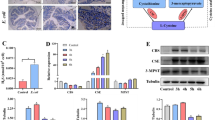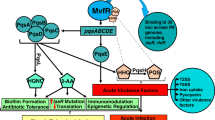Abstract
Hypervirulent Klebsiella pneumoniae (hvKP) is a highly lethal opportunistic pathogen that elicits more severe inflammatory responses compared to classical Klebsiella pneumoniae (cKP). In this study, we investigated the interaction between hvKP infection and the anti-inflammatory immune response gene 1 (IRG1)-itaconate axis. Firstly, we demonstrated the activation of the IRG1-itaconate axis induced by hvKP, with a dependency on SYK signaling rather than STING. Importantly, we discovered that exogenous supplementation of itaconate effectively inhibited excessive inflammation by directly inhibiting SYK kinase at the 593 site through alkylation. Furthermore, our study revealed that itaconate effectively suppressed the classical activation phenotype (M1 phenotype) and macrophage cell death induced by hvKP. In vivo experiments demonstrated that itaconate administration mitigated hvKP-induced disturbances in intestinal immunopathology and homeostasis, including the restoration of intestinal barrier integrity and alleviation of dysbiosis in the gut microbiota, ultimately preventing fatal injury. Overall, our study expands the current understanding of the IRG1-itaconate axis in hvKP infection, providing a promising foundation for the development of innovative therapeutic strategies utilizing itaconate for the treatment of hvKP infections.
Graphical abstract






Similar content being viewed by others
References
Russo TA, Marr CM (2019) Hypervirulent Klebsiella pneumoniae. Clin Microbiol Rev 32(3):e00001-19
Choby JE, Howard-Anderson J, Weiss DS (2020) Hypervirulent Klebsiella pneumoniae - clinical and molecular perspectives. J Intern Med 287(3):283–300
Decre D et al (2011) Emerging severe and fatal infections due to Klebsiella pneumoniae in two university hospitals in France. J Clin Microbiol 49(8):3012–3014
Wang X et al (2023) Pyroptosis, apoptosis, and autophagy are involved in infection induced by two clinical Klebsiella pneumoniae isolates with different virulence. Front Cell Infect Microbiol 13:1165609
Russo TA et al (2021) An assessment of siderophore production, mucoviscosity, and mouse infection models for defining the virulence spectrum of hypervirulent Klebsiella pneumoniae. mSphere 6(2):e00045-e121
Raffelsberger N et al (2021) Gastrointestinal carriage of Klebsiella pneumoniae in a general adult population: a cross-sectional study of risk factors and bacterial genomic diversity. Gut Microbes 13(1):1939599
Martin RM et al (2016) Molecular Epidemiology of Colonizing and Infecting Isolates of Klebsiella pneumoniae. mSphere 1(5):e00261-e316
Wu X, Ren J, Li J (2016) Maintenance of intestinal barrier function in patients with chronic critical illness. Zhonghua Wei Chang Wai Ke Za Zhi 19(7):740–742
Corriero A et al (2022) The central role of the gut in intensive care. Crit Care 26(1):379
Jung J, Zeng H, Horng T (2019) Metabolism as a guiding force for immunity. Nat Cell Biol 21(1):85–93
Hooftman A et al (2020) The immunomodulatory metabolite itaconate modifies NLRP3 and inhibits inflammasome activation. Cell Metab 32(3):468-478 e7
Mills EL et al (2018) Itaconate is an anti-inflammatory metabolite that activates Nrf2 via alkylation of KEAP1. Nature 556(7699):113–117
Runtsch MC et al (2022) Itaconate and itaconate derivatives target JAK1 to suppress alternative activation of macrophages. Cell Metab 34(3):487-501 e8
Li W et al (2023) 4-octyl itaconate as a metabolite derivative inhibits inflammation via alkylation of STING. Cell Rep 42(3):112145
Yamaguchi A et al (2022) Pulsed-ultrasound irradiation induces the production of itaconate and attenuates inflammatory responses in macrophages. J Inflamm Res 15:2387–2395
Sohail A et al (2022) Itaconate and derivatives reduce interferon responses and inflammation in influenza a virus infection. PLoS Pathog 18(1):e1010219
Peace CG, O’Neill LA (2022) The role of itaconate in host defense and inflammation. J Clin Invest. https://doi.org/10.1172/JCI148548
Li Y et al (2022) The IRG1-Itaconate axis: a regulatory hub for immunity and metabolism in macrophages. Int Rev Immunol. https://doi.org/10.1080/08830185.2022.2067153
Kim HW et al (2022) Aconitate decarboxylase 1 deficiency exacerbates mouse colitis induced by dextran sodium sulfate. Int J Mol Sci 23(8):4392
Chen F et al (2022) The STING1-MYD88 complex drives ACOD1/IRG1 expression and function in lethal innate immunity. iScience 25(7):104561
Rittenhouse JW, McFadden BA (1974) Inhibition of isocitrate lyase from Pseudomonas indigofera by itaconate. Arch Biochem Biophys 163(1):79–86
Nandakumar M, Nathan C, Rhee KY (2014) Isocitrate lyase mediates broad antibiotic tolerance in Mycobacterium tuberculosis. Nat Commun 5(1):4306
Riquelme SA et al (2019) CFTR-PTEN-dependent mitochondrial metabolic dysfunction promotes Pseudomonas aeruginosa airway infection. Sci Transl Med 11(499):eaav4634
Riquelme SA et al (2020) Pseudomonas aeruginosa utilizes host-derived itaconate to redirect its metabolism to promote biofilm formation. Cell Metab 31(6):1091-1106 e6
Nair S et al (2018) Irg1 expression in myeloid cells prevents immunopathology during M. tuberculosis infection. J Exp Med 215(4):1035–1045
Tang S, Yu Q, Ding C (2022) Investigational spleen tyrosine kinase (SYK) inhibitors for the treatment of autoimmune diseases. Expert Opin Investig Drugs 31(3):291–303
Sahan-Firat S et al (2019) NF-kappaB activation mediates LPS-or zymosan-induced hypotension and inflammation reversed by BAY61-3606, a selective Syk inhibitor, in rat models of septic and non-septic shock. Clin Exp Pharmacol Physiol 46(2):173–182
Pamuk ON et al (2010) Spleen tyrosine kinase inhibition prevents tissue damage after ischemia-reperfusion. Am J Physiol Gastrointest Liver Physiol 299(2):G391–G399
Gong W et al (2020) Mincle/Syk signalling promotes intestinal mucosal inflammation through induction of macrophage pyroptosis in Crohn’s disease. J Crohns Colitis 14(12):1734–1747
Gong W et al (2021) CCL4-mediated targeting of spleen tyrosine kinase (Syk) inhibitor using nanoparticles alleviates inflammatory bowel disease. Clin Transl Med 11(2):e339
Alhazmi A, Choi J, Ulanova M (2018) Syk inhibitor R406 downregulates inflammation in an in vitro model of Pseudomonas aeruginosa infection. Can J Physiol Pharmacol 96(2):182–190
Nguyen GT et al (2021) Neutrophils require SKAP2 for reactive oxygen species production following C-type lectin and Candida stimulation. iScience 24(8):102871
Antunes G et al (2002) Systemic cytokine levels in community-acquired pneumonia and their association with disease severity. Eur Respir J 20(4):990–995
Nguyen GT et al (2020) SKAP2 is required for defense against K. pneumoniae infection and neutrophil respiratory burst. Elife. https://doi.org/10.7554/eLife.56656
Lin MH et al (2009) Phosphoproteomics of Klebsiella pneumoniae NTUH-K2044 reveals a tight link between tyrosine phosphorylation and virulence. Mol Cell Proteom 8(12):2613–2623
Zheng X et al (2022) Time-course transcriptome analysis of lungs from mice infected with hypervirulent klebsiella pneumoniae via aerosolized intratracheal inoculation. Front Cell Infect Microbiol 12:833080
Chen F et al (2019) Crystal structure of cis-aconitate decarboxylase reveals the impact of naturally occurring human mutations on itaconate synthesis. Proc Natl Acad Sci U S A 116(41):20644–20654
Michelucci A et al (2013) Immune-responsive gene 1 protein links metabolism to immunity by catalyzing itaconic acid production. Proc Natl Acad Sci U S A 110(19):7820–7825
Mills EL, O’Neill LA (2016) Reprogramming mitochondrial metabolism in macrophages as an anti-inflammatory signal. Eur J Immunol 46(1):13–21
Coffey G et al (2017) PRT062607 achieves complete inhibition of the spleen tyrosine kinase at tolerated exposures following oral dosing in healthy volunteers. J Clin Pharmacol 57(2):194–210
Braselmann S et al (2006) R406, an orally available spleen tyrosine kinase inhibitor blocks fc receptor signaling and reduces immune complex-mediated inflammation. J Pharmacol Exp Ther 319(3):998–1008
Liu R et al (2020) Spermidine endows macrophages anti-inflammatory properties by inducing mitochondrial superoxide-dependent AMPK activation, Hif-1alpha upregulation and autophagy. Free Radic Biol Med 161:339–350
Paone P, Cani PD (2020) Mucus barrier, mucins and gut microbiota: the expected slimy partners? Gut 69(12):2232–2243
Nagao-Kitamoto H et al (2020) Interleukin-22-mediated host glycosylation prevents Clostridioides difficile infection by modulating the metabolic activity of the gut microbiota. Nat Med 26(4):608–617
Liu R et al (2022) Lachnospira is a signature of antihistamine efficacy in chronic spontaneous urticaria. Exp Dermatol 31(2):242–247
Qin W et al (2020) Chemoproteomic profiling of itaconation by bioorthogonal probes in inflammatory macrophages. J Am Chem Soc 142(25):10894–10898
Lampropoulou V et al (2016) Itaconate links inhibition of succinate dehydrogenase with macrophage metabolic remodeling and regulation of inflammation. Cell Metab 24(1):158–166
Shao Y et al (2021) Recent advance of spleen tyrosine kinase in diseases and drugs. Int Immunopharmacol 90:107168
Liu D, Mamorska-Dyga A (2017) Syk inhibitors in clinical development for hematological malignancies. J Hematol Oncol 10(1):145
Waqas FH et al (2023) NRF2 activators inhibit influenza A virus replication by interfering with nucleo-cytoplasmic export of viral RNPs in an NRF2-independent manner. PLoS Pathog 19(7):e1011506
Connors J, Dawe N, Van Limbergen J (2018) The role of succinate in the regulation of intestinal inflammation. Nutrients 11(1):25
Venkatesh B et al (2018) Adjunctive glucocorticoid therapy in patients with septic shock. N Engl J Med 378(9):797–808
Chen F et al (2023) Amino acid positions near the active site determine the reduced activity of human ACOD1 compared to murine ACOD1. Sci Rep 13(1):10360
Gong W et al (2022) STING-mediated Syk signaling attenuates tumorigenesis of colitis-associated colorectal cancer through enhancing intestinal epithelium pyroptosis. Inflamm Bowel Dis 28(4):572–585
Wu J et al (2022) The interaction between STING and NCOA4 exacerbates lethal sepsis by orchestrating ferroptosis and inflammatory responses in macrophages. Cell Death Dis 13(7):653
Acknowledgements
We would like to dedicate this article in memory of the late Professor Jieshou Li, a renowned academician of the Chinese Academy of Engineering and a professor at Nanjing University. Professor Li was known for his exceptional kindness, amicability, and unwavering support towards students.
Funding
This work was supported by National Natural Science Foundation of China (82072223, 82072149, 82272237, 82272209), Key Research and Development Program of Jiangsu Province (BE2022823), the Natural Science Foundation of Jiangsu Province (BK20201116), Medical scientific research project of Jiangsu Health Committee (ZDB2020028, M2020052).
Author information
Authors and Affiliations
Contributions
YL: Conceptualization, Methodology, Software, Investigation, Resources, Formal Analysis, Writing, Visualization. YX: Methodology, Software, Resources, Formal Analysis; WL: Conceptualization, Methodology, Resources, Investigation. JL: Methodology, Resources, Validation. WW, JK, HJ, PL, JL, WG, XL, CN, ML, LC and SL: Methodology, Investigation. XW, YZ and JR: Resources, Writing—Review & Editing, Supervision, Funding acquisition.
Corresponding authors
Ethics declarations
Conflict of interest
All authors declare no conflict of interest.
Ethical approval and consent to participate
The experimental protocols adhered to the Chinese guideline for the care and use of laboratory animals (Ministry of Science and Technology [2006] file no. 398) and received approval from the Institutional Animal Care and Use Committee of Jinling Hospital (approval number 2022DZGKJDWLS-0074).
Consent for publication
All co-authors have reviewed and approved the final version of the manuscript and agree to its submission for publication.
Additional information
Publisher's Note
Springer Nature remains neutral with regard to jurisdictional claims in published maps and institutional affiliations.
Supplementary Information
Below is the link to the electronic supplementary material.
Rights and permissions
Springer Nature or its licensor (e.g. a society or other partner) holds exclusive rights to this article under a publishing agreement with the author(s) or other rightsholder(s); author self-archiving of the accepted manuscript version of this article is solely governed by the terms of such publishing agreement and applicable law.
About this article
Cite this article
Li, Y., Xu, Y., Li, W. et al. Itaconate inhibits SYK through alkylation and suppresses inflammation against hvKP induced intestinal dysbiosis. Cell. Mol. Life Sci. 80, 337 (2023). https://doi.org/10.1007/s00018-023-04971-w
Received:
Revised:
Accepted:
Published:
DOI: https://doi.org/10.1007/s00018-023-04971-w




